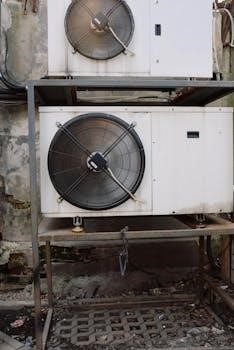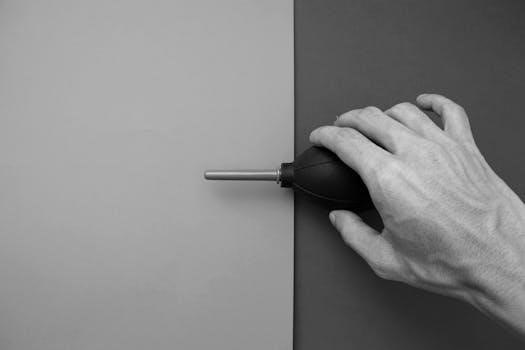
Porter-Cable Air Compressor Manual 150 PSI⁚ Overview
The Porter-Cable 150 PSI air compressor is designed for various tasks, from inflating tires to powering pneumatic tools. These compressors are known for their portability and ease of use, appealing to both homeowners and professionals. They offer a reliable source of compressed air for multiple applications.
The Porter-Cable 150 PSI air compressor line represents a collection of robust and versatile tools designed to meet a variety of compressed air needs. These compressors, often featuring a pancake-style design for stability, are popular among both DIY enthusiasts and professional tradespeople. The 150 PSI rating indicates the maximum pressure the compressor can deliver, suitable for tasks ranging from inflating tires and sports equipment to operating pneumatic nailers, spray guns, and other air tools. Models like the C2002, CMB15, and CPFAC2600P are frequently chosen for their reliability and ease of use. The oil-free pump design eliminates the need for regular maintenance, making these compressors convenient options. With features like dual couplers and a focus on efficient air flow, Porter-Cable 150 PSI compressors are engineered for both performance and user convenience. They typically feature a low-amp motor to prevent electrical issues and a water drain valve for efficient moisture removal.
Key Features and Benefits
Porter-Cable 150 PSI air compressors boast several key features and benefits that make them a popular choice for various applications. A prominent advantage is the oil-free pump design, which significantly reduces maintenance requirements, eliminating the need for oil changes and minimizing the risk of leaks. The 150 PSI maximum pressure provides ample power for a wide range of pneumatic tools and inflation tasks. Many models come equipped with two regulated, factory-installed air couplers, allowing two users to operate simultaneously. The pancake-style tank design enhances stability during operation. The compressors are designed with optimized airflow to ensure quick recovery times, often delivering around 2.6 SCFM at 90 PSI. A low-amp motor is often incorporated, reducing the likelihood of tripped breakers during start-up. The inclusion of a water drain valve and durable rubber feet enhances both usability and longevity. Portability is another crucial benefit, making them easy to transport and store, further increasing their appeal.

Porter-Cable 150 PSI Models and Specifications
Three popular Porter-Cable 150 PSI air compressor models include the C2002, a 6-gallon pancake compressor; the CMB15, a portable 1.5-gallon unit; and the CPFAC2600P, another pancake-style model. Each caters to different needs.
Common Models⁚ C2002, CMB15, and CPFAC2600P
The Porter-Cable C2002 is a popular 6-gallon pancake-style compressor, ideal for tasks like trim finishing, small framing, and general inflation. It features an oil-free pump for low maintenance and two regulated air couplers to support two users simultaneously. Its steel construction provides durability, while its upgraded shroud protects vital components. The CMB15 is a more portable 1.5-gallon compressor, designed for inflation and pneumatic tool applications. Its compact design and oil-free pump make it convenient for various tasks with minimal maintenance. The CPFAC2600P is another pancake compressor model, emphasizing stability with its design. These models are all designed to operate at or below 150 PSI, offering reliable performance for a wide array of applications. Each model caters to different needs regarding portability and air storage capacity, but all share the brand’s commitment to quality and performance. They come equipped with features intended to ensure ease of use and longevity.
Technical Specifications⁚ PSI, Tank Capacity, and SCFM
Porter-Cable 150 PSI air compressors are characterized by their high maximum pressure of 150 PSI, allowing them to power a variety of pneumatic tools effectively. Tank capacities vary across models, with common sizes including 1.5 gallons for highly portable units and 6 gallons for more extensive use. The 6-gallon models often use a pancake-style tank, designed for stability. The compressor’s SCFM (Standard Cubic Feet per Minute) rating indicates the airflow it can deliver. For example, some models deliver 2.6 SCFM at 90 PSI, ensuring quick recovery times. These specifications are important to consider for matching the compressor to the specific demands of your tools and applications. The oil-free pump design contributes to low maintenance, removing the need for regular oil changes and reducing the risk of leaks. The combination of PSI, tank capacity, and SCFM ensures that these compressors can meet the needs of various users effectively, from homeowners to professionals.

Operation and Safety
Prior to use, ensure proper setup by checking all connections and verifying that the unit is on a stable surface. Follow the manual’s instructions to operate the compressor safely and effectively, while always monitoring pressure.
Initial Setup and Operating Instructions
Before operating your Porter-Cable 150 PSI air compressor, a thorough initial setup is crucial. Begin by carefully unpacking the unit and inspecting all components for any damage. Place the compressor on a stable, level surface that allows for proper ventilation. Connect the air hose to the compressor’s outlet and ensure all fittings are tight and secure. Verify that the power switch is in the ‘off’ position before plugging the power cord into a grounded outlet. Next, familiarize yourself with the compressor’s controls, including the pressure regulator and gauge. Start by turning on the unit, allowing it to reach the desired pressure and then shut off automatically. Always refer to the specific model’s manual for detailed instructions and follow all recommended safety precautions to ensure proper and safe operation. The compressor is designed to reach a maximum pressure of 150 PSI, which is important to note before starting any project.
Safety Guidelines and Precautions
Operating a Porter-Cable 150 PSI air compressor requires strict adherence to safety guidelines. Always wear appropriate personal protective equipment, including safety glasses and ear protection, when using the compressor. Never exceed the compressor’s maximum pressure rating of 150 PSI, as over-pressurization can cause damage or injury. Before each use, inspect the air hose and fittings for any signs of wear or damage. Ensure the compressor is on a stable, level surface and is adequately ventilated. Keep the work area clear of debris and flammable materials. Never operate the compressor near water or in wet conditions. Always turn off and unplug the compressor before performing any maintenance or adjustments. Be aware of the noise level and avoid prolonged exposure. Regularly check for air leaks and address them promptly. If any issues arise, consult the owner’s manual for troubleshooting. Finally, always remember that compressed air can be dangerous if used improperly, so use caution.

Maintenance and Troubleshooting
Regular maintenance ensures the Porter-Cable 150 PSI air compressor operates efficiently. This includes draining the tank regularly to remove moisture, inspecting the air filter, and checking for leaks. Lubricate moving parts if required, following the manual’s instructions. These simple steps can extend the life of your compressor.
Routine Maintenance Procedures
Maintaining your Porter-Cable 150 PSI air compressor is crucial for its longevity and optimal performance. A key procedure is regularly draining the air tank to eliminate accumulated moisture, preventing rust and corrosion. This should be done after each use or at least weekly. The air filter should be inspected and cleaned or replaced periodically to ensure proper airflow and prevent debris from entering the pump. Check the compressor for any air leaks, tightening fittings or replacing worn parts if needed. The oil-free pump design simplifies maintenance by eliminating oil changes; however, other components still require attention. Inspect the safety valve to ensure it’s functioning properly. Periodically review the pressure switch for correct operation, and always keep the compressor clean from dust and dirt. Regularly check the power cord for damage. Following these routine steps will contribute to the reliable and efficient operation of your compressor.
Troubleshooting Common Issues
Encountering problems with your Porter-Cable 150 PSI air compressor can be frustrating, but many issues can be resolved with simple troubleshooting; If the compressor fails to start, ensure it’s plugged in and the power switch is on. Check the circuit breaker or fuse for any trips. If the compressor runs but doesn’t build pressure, inspect for air leaks in hoses or fittings. A faulty pressure switch could also be the culprit. If the unit is noisy or vibrates excessively, look for loose parts or mounting hardware. Overheating might indicate a blocked air filter or insufficient ventilation. If the compressor cycles too frequently, check for leaks in the tank or lines. If the safety valve releases air unexpectedly, it might be an overpressure issue. Refer to the manual for specific error codes and recommended solutions. When in doubt, contact a qualified service technician for assistance. Remember to always unplug the unit before performing any maintenance or troubleshooting.
Additional Resources
The owner’s manual is essential for operating and maintaining your Porter-Cable air compressor. It includes safety guidelines, operating instructions, and troubleshooting tips. You can often find it online using the model number or through the service site.
Finding and Using the Owner’s Manual
Locating the correct owner’s manual for your Porter-Cable 150 PSI air compressor is crucial for safe and efficient operation. The manual contains vital information, including detailed instructions on setup, operation, maintenance, and troubleshooting. A good starting point is the manufacturer’s website, where you can often find digital copies of manuals by searching for your specific model number, such as C2002, CMB15, or CPFAC2600P. Additionally, third-party sites like SERVICENET may also provide access to manuals. When using the manual, pay close attention to the safety guidelines and warnings to prevent accidents. The manual also outlines routine maintenance procedures, like draining the tank and checking for leaks, which are vital to extending the compressor’s lifespan. Understanding the technical specifications detailed in the manual, such as PSI, SCFM, and tank capacity, will enable you to operate your compressor effectively. Always refer to the manual if you encounter any issues or have questions about your compressor’s operation.
Warranty and Support Information
Understanding the warranty and support options for your Porter-Cable 150 PSI air compressor is essential for protecting your investment. Typically, Porter-Cable offers a limited warranty on their air compressors, covering defects in materials and workmanship for a specific period. The exact terms of the warranty, including the duration and what is covered, can be found in the owner’s manual or on the company’s official website. Should you encounter issues covered by the warranty, contacting Porter-Cable’s customer support is the first step. They can guide you through the process of repair or replacement. Beyond warranty coverage, Porter-Cable provides customer support for various issues related to the air compressor. This support might include troubleshooting assistance, parts availability, and information on authorized service centers. Always have your model number and purchase details available when seeking support. Additionally, online forums and communities can also provide valuable peer-to-peer support and advice from other Porter-Cable users.
